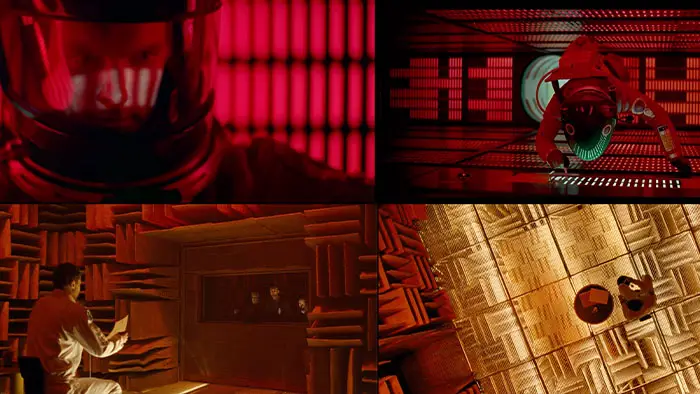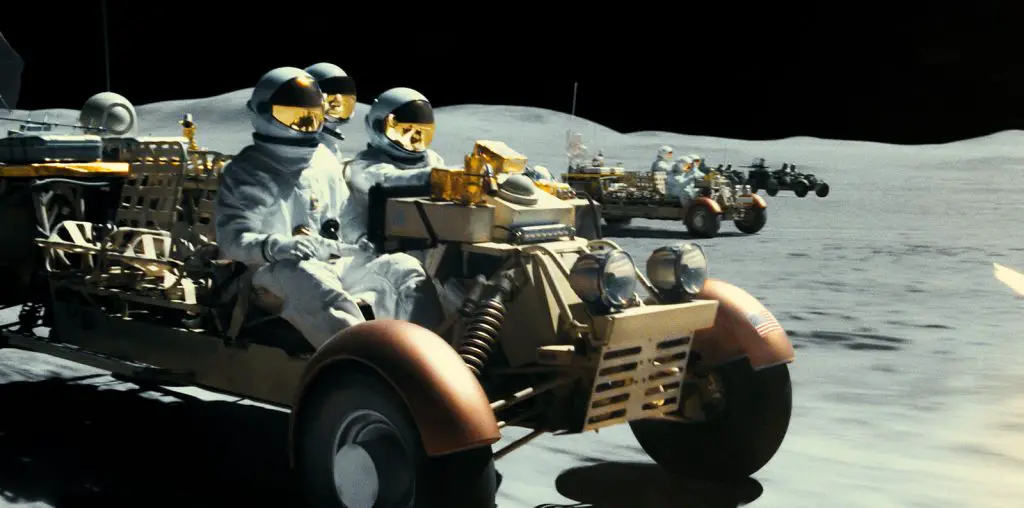
Sadly, that’s not at all what we get. This version of humanity would seem to be more scientific, more yearning, and more centered on the really big questions than any country today. Yet inexplicably, this has been achieved by paranoid, deceitful, and controlling military organization. How did this happen? The movie is silent. It seems to be shoehorned in as an attempted commentary on Trump’s Space Force. I’d love to see a film on the perils of the militarization of space, and how it undercuts the inspiring and humanity-unifying “We Came In Peace For All Mankind” ethos of the Apollo era. Sadly, Ad Astra does the opposite. We’re forced to ask — if the military gets us cities on the moon, bases on Mars, crewed interplanetary scientific missions to Neptune, and extraordinary towers to search for alien life — isn’t that something we should be embracing?
We’re left with a dreary film where all the awe and wonder is right there in the background but is never embraced. The search for life is only used as a theme to be just a knock-you-over-the-head metaphor for the inability to connect with other humans. There have been thousands of movies about the pedestrian theme of human connection, but only a handful to treat the search for extraterrestrial life with any kind of seriousness. When the subtext is more interesting than the text, you should swap them.
From the look of the shots to the idea of a lonely journey through the solar system to find life, Ad Astra desperately wants to be 2001: A Space Odyssey. But 2001 had the genius of Stanley Kubrick, and Ad Astra has the mediocrity of James Gray. In 2001, you get an astounding sideways shot of an astronaut jogging through one side of the frame and coming up the other. Not only is it innovative, it serves to communicate simultaneously the means of creating artificial gravity, the isolation of space travel, and ideas of “fitness,” which will come into play with the showdown with HAL. Compare that to Ad Astra, where even on the Moon, the gravity swaps back and forth between lunar-looking gravity in part of a moon buggy scene, but Earth gravity when inside the moon base.

“Good science advisors don’t just help you with the science, they help ground the plot and characters, allowing you to reach even farther.”
Or take 2001’s stunning scene of Dave, lit in a violent blood-red as he’s inside the brain of HAL, taking it apart thought by thought. Jarring overhead shots of Dave in a spacesuit show you the layout and remind you HAL is trying to kill Dave, even as he tries to manipulate him emotionally. There’s an equivalent scene in Ad Astra, complete with our astronaut surrounded in a room with vertical red lines and an overhead shot. But here that just serves to remind you of how Ad Astra is trying to lift the style and gravitas of 2001 without any of the genius. The lines are ostensibly because it is a sound-absorbing room on Mars, and Brad Pitt has to be there to record a transmission to send to his father. It is the thinnest of excuses to get him to Mars. Even if the secure laser facility is on Mars, Brad Pitt could have recorded that anywhere — he didn’t even need a super sound damping room. There are no clues where we are because gravity obeys Earth’s gravity. And Brad Pitt transmits a message and gets a return answer in seconds, without the 4 hours each way light travel time. The movie also never follows up on that message. Wouldn’t Tommy Lee Jones have said, “Hey, I’m aware of the situation and trying to fix the explosions?” And if the military was hell-bent on killing him, why send a crew with the nuclear weapon and risk their lives?


I found the premise that the anti-matter beams were focused on earth ridiculous. If this was really a problem, wouldn’t TLJones have self-destructed or at least sent a warning to earth about the problem. If the anti-matter was the propulsion system of the Neptune mission, wouldn’t TLJones try to continue the mission to the stars after he killed the rest of the crew? This doesn’t seem to be in the plot. The data that is passed on to Brad Pitt seems very brief and inconclusive: Images of planets are not enough- what about traces of life, even microbial? What about a human compatible planet? Are they only looking for intelligent life, instead of ANY extraterrestrial life? Here’s a better ending: the destruction of the Neptune ship causes a mini-black hole or space-worm that sucks Brad Pitt outward at near light speed. Thus, he becomes the real star explorer and will try to reach the next planet, though probably to never return. This was sort of the ending of Mission to Mars, where Gary Sinese decides to ride the free trip to the alien destination, rather than return to earth. Don’t know if the science was any good on that film, but I found it much more satisfying. Remember the madness of the remaining astronaut on Mars who was surviving on growing plants (Don Cheadle)? That was a great scene which showed the fragility of human nature on another planet.